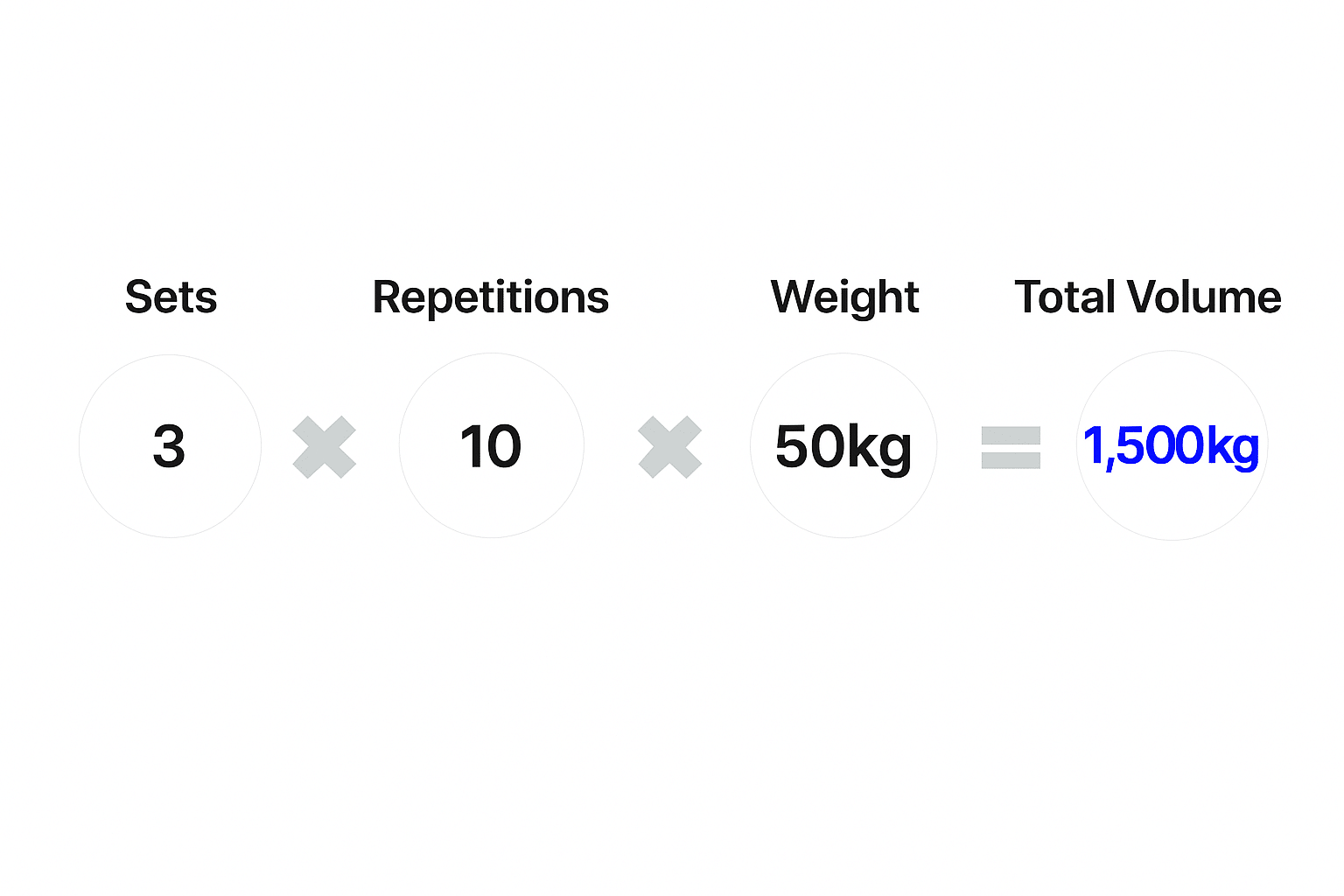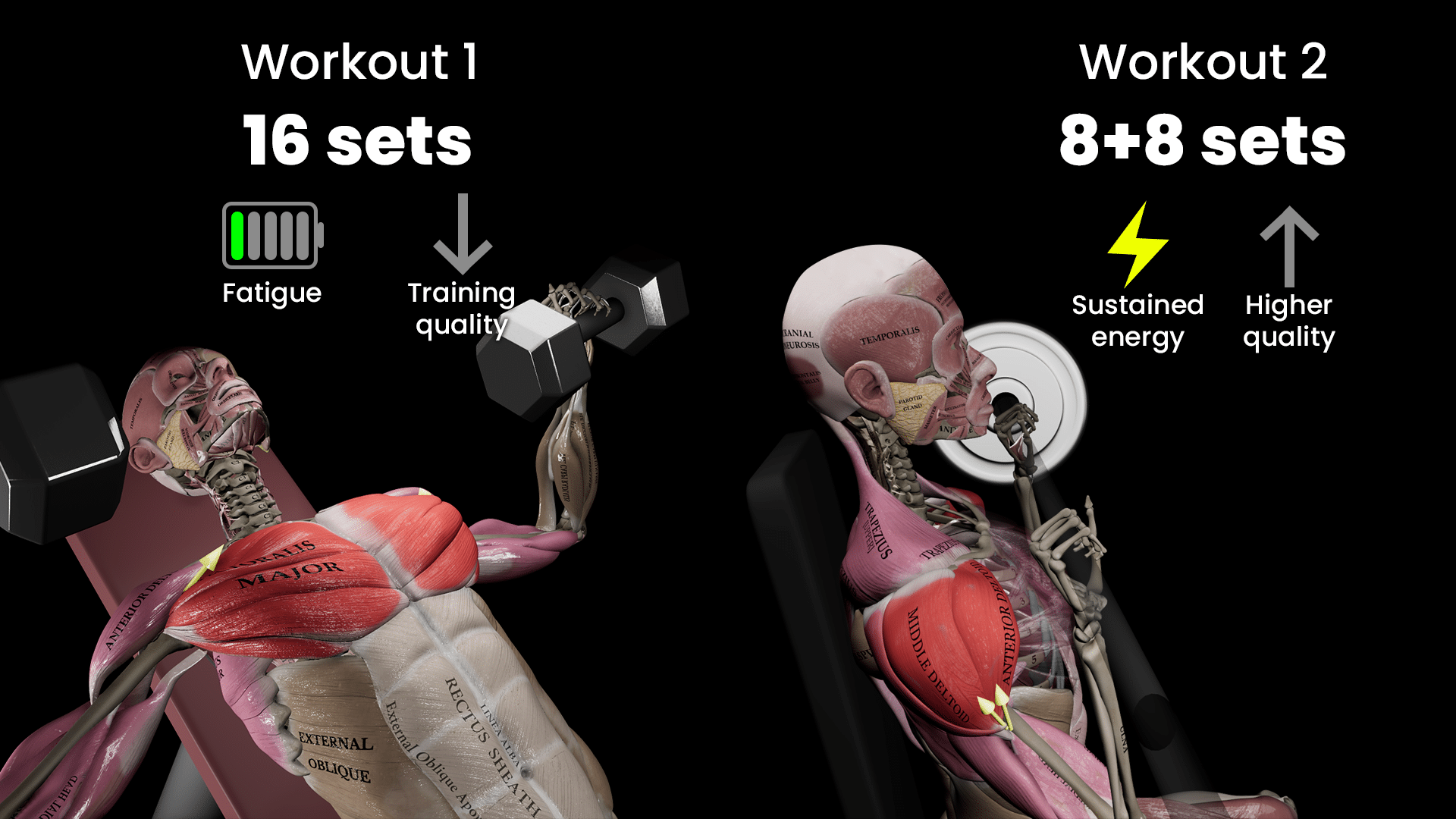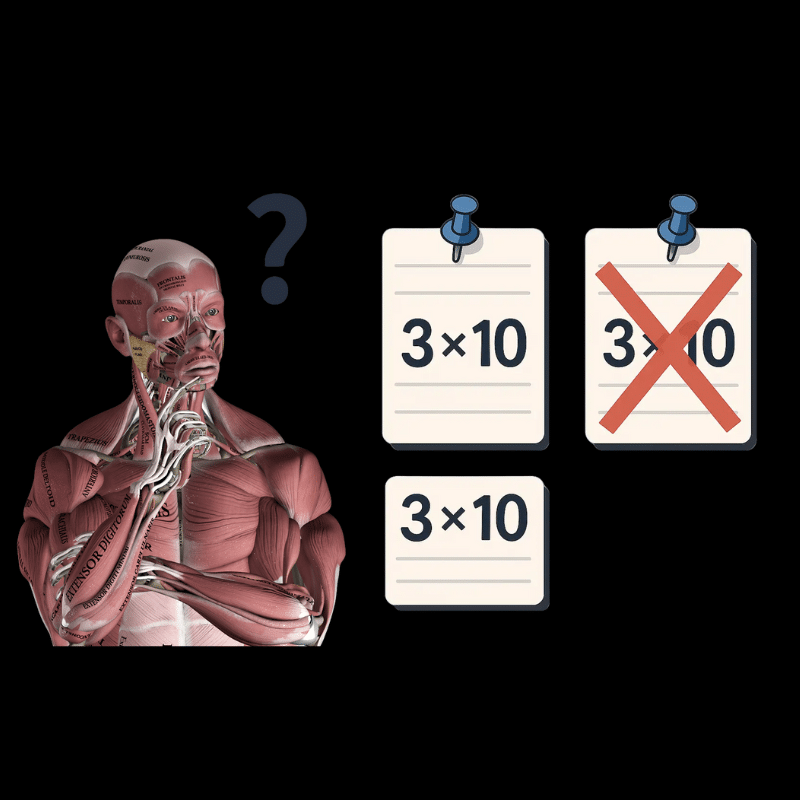Have you ever wondered why so many workout plans stick to three sets of ten reps? While it’s a familiar formula, the science behind training volume is far more advanced.
In this Muscle and Motion article, we’ll explain what training volume means, why counting “hard sets” offers better insights than simply tallying weights and reps, and how to tailor your training volume to maximize results. You’ll also learn why one-size-fits-all programs often fall short and how to adjust your workouts to match your experience level, recovery capacity, and personal goals. By the end, you’ll have evidence-based strategies to help you train smarter, not harder.
What is training volume?
Training volume refers to the total work your muscles perform during a workout or over several weeks. It’s most commonly measured by multiplying the number of sets, repetitions, and the amount of weight lifted. For example, performing three sets of 10 repetitions with 50 kilograms yields a total volume of 1,500 kilograms for that exercise.

However, while this method, known as volume load, is useful, it doesn’t tell the whole story. That’s because not all sets are created equal. A set far from failure won’t stimulate your muscles as effectively as one that pushes you close to your limit.
Why hard sets matter
That’s why researchers and coaches today often focus on a more practical measure: the number of hard sets per muscle group weekly. A hard set is performed with high effort, typically close to muscular failure. For example, if you perform eight reps of a barbell bench press and the final rep feels very challenging, that counts as one hard set. The same applies if you perform 16 reps and struggle to complete the last rep. This approach gives a clearer picture of the actual stimulus your muscles receive and is more strongly linked to hypertrophy. (Check out this article to learn more about training close to failure.)
How to count sets for each muscle?
One of the most common questions lifters ask is, “Wait, if I do a bench press, am I only training my chest? What about the triceps or shoulders? Do those count as well?” Great question.
The short answer is yes, but with some important context.
When performing compound exercises like the barbell bench press, multiple muscles are involved:
✅ Chest (pectoralis major): The main driver of the movement
✅ Front deltoid: Actively assists during shoulder flexion
✅ Triceps: Extend the elbows and contribute significantly to pressing force
If all these muscles are working hard and moving through a meaningful range of motion, especially when you’re training close to failure, we typically count it as one complete set for each of those muscle groups. So, three sets of bench press = 3 sets for chest, front delts, and triceps.
This method is commonly used in research to calculate training volume, providing a practical way to estimate muscular workload without overcomplicating the process.
Some experts advocate for a more nuanced method, counting 1 set for primary movers and 0.5 sets for secondary muscles. Using the bench press as an example, this would mean 1 set for the chest, and 0.5 sets each for the triceps and front delts.
But for this blog, we’ll stick with the classic and widely used approach: counting one complete set for each major muscle group involved. It’s simpler, effective, and aligns with most training volume and hypertrophy research.
Now that you know how to count sets per muscle, let’s explore how many of them you need to grow.
How many hard sets per week are required to maximize muscle growth?
A 2022 systematic review and meta-analysis by Baz-Valle and colleagues sought to answer that question. They analyzed randomized controlled trials involving trained men with at least one year of experience in resistance training. The studies included had to report direct muscle growth measurements and the number of sets performed per week.
Training volume categories
The researchers categorized training volume into three levels:
- Low volume: Less than 12 sets per muscle group per week
- Moderate volume: 12 to 20 sets per week
- High volume: More than 20 sets per week
Interestingly, the analysis only compared moderate and high-volume groups. For most muscle groups, including the quadriceps and biceps, there were no statistically significant differences in muscle growth between performing 12-20 sets and more than 20 sets. This suggests that moderate training volumes may be sufficient for maximizing hypertrophy if the sets are performed with high effort.
However, one exception stood out: the triceps. Unlike other muscles, the triceps brachii exhibited a clear dose-response relationship, indicating that hypertrophy continued to increase with higher weekly set volumes. One possible reason is that the triceps often act as secondary movers in compound pressing exercises and may not receive enough direct stimulation unless specifically targeted.
Where to begin: 10-12 Sets per muscle group weekly
Most evidence-based recommendations, including those by Schoenfeld and Baz-Valle et al., highlight a weekly range of 10 to 12 hard sets per muscle group as a smart starting point for hypertrophy. This range provides sufficient stimulus to promote muscle growth in most trainees without overwhelming their recovery capacity. It strikes a balance between doing too little and risking plateaus or doing too much and accumulating unnecessary fatigue.
However, it’s essential to remember that this isn’t a rigid rule, but rather a baseline. Some individuals may thrive on slightly lower volumes, while others may require higher volumes to maintain continued progress. From this foundation, volume can gradually increase or decrease depending on your recovery, training response, and goals. Monitoring progress, adjusting based on feedback from your body, and maintaining consistency with your efforts are key to making this range work for you.

Finding your optimal training volume: Why one size doesn’t fit all
While scientific studies provide helpful guidelines, it’s essential to understand that their conclusions reflect average responses, not individual ones. People vary widely in their responses to training: some achieve great results with lower volumes, while others require higher volumes to trigger meaningful muscle growth. Research shows that individuals who don’t initially respond to strength training often begin to improve once their training volume increases.
The commonly recommended range of 10-12 hard sets per muscle group per week should be viewed as a practical starting point, not a rigid rule. Your training history also plays a role: beginners typically benefit from lower volumes. However, as you become more experienced, your body adapts and may require more effort to continue progressing. This concept, known as volume progression, is supported by studies demonstrating that gradually increasing weekly set volume over time can enhance hypertrophy, particularly in well-trained individuals with good recovery capacity and structured training programs.
Sets per session
Knowing your weekly set goal is helpful, but how you distribute those sets across the week matters just as much. Doing too many sets for the same muscle group in a single workout can lead to diminishing returns, often referred to as “junk volume.”
Most coaches recommend aiming for 6-10 sets of hard work per muscle group per session. Beyond that, the extra volume may not lead to additional gains but could cause unnecessary fatigue. For example, if your target is 16 weekly sets for chest, it’s usually better to split them into two sessions of 8 sets rather than doing all 16 in one go. This approach helps maintain intensity, supports better recovery, and maintains high training quality throughout the workout.

In summary, muscle growth isn’t about doing more for the sake of more; it’s about consistently doing the right amount of quality work. While the research provides a reliable starting point, typically 10-12 hard sets per muscle group per week, remember that these numbers are averages, not absolutes.
Everyone responds differently to training. Some lifters thrive on lower volumes, while others require higher volumes to trigger adaptation. That’s why the best results come from adjusting your training volume based on recovery, performance, and progress. Don’t be afraid to experiment, track your results, and fine-tune as needed.
Perhaps most importantly, a great coach doesn’t rely solely on numbers; they use them as a guide. By observing how you move, recover, and grow, an experienced coach can help personalize your training volume to match your individual needs, ensuring long-term progress and reducing the risk of burnout.
At Muscle and Motion, we believe that knowledge is power, and understanding the ‘why’ behind any exercise is essential for your long-term success.
Let the Strength Training App help you achieve your goals! Sign up for free.
Reference:
- Baz-Valle, E., Balsalobre-Fernández, C., Alix-Fages, C., & Santos-Concejero, J. (2022). A systematic review of the effects of different resistance training volumes on muscle hypertrophy. Journal of Human Kinetics, 81(1), 199–210.
- Schoenfeld, B. J., Ogborn, D., & Krieger, J. W. (2017). Dose-response relationship between weekly resistance training volume and increases in muscle mass: A systematic review and meta-analysis. Journal of Sports Sciences, 35(11), 1073–1082.
- Aube, D., Wadhi, T., Rauch, J., Anand, A., Barakat, C., Pearson, J., Bradshaw, J., Zazzo, S., Ugrinowitsch, C., & De Souza, E. O. (2022). Progressive resistance training volume: Effects on muscle thickness, mass, and strength adaptations in resistance-trained individuals: Effects on muscle thickness, mass, and strength adaptations in resistance-trained individuals. Journal of Strength and Conditioning Research, 36(3), 600–607.


